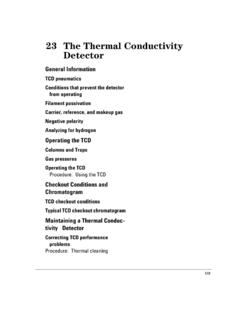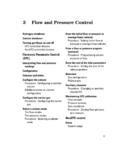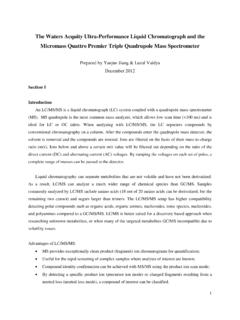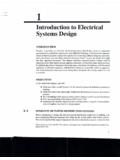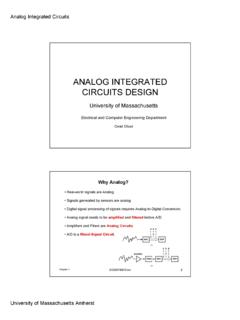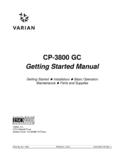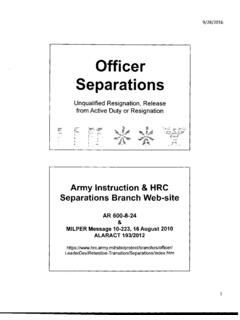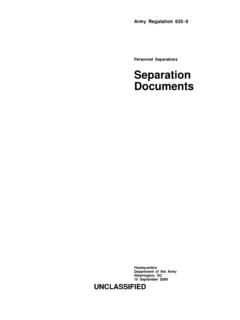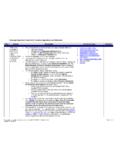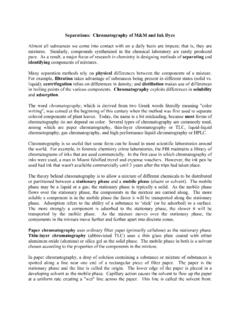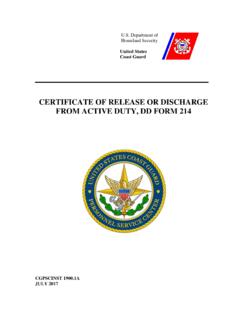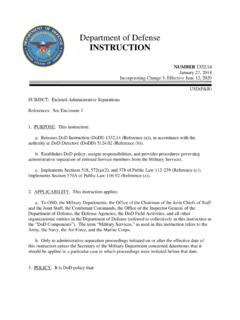Transcription of 2690 Separations Module Operator's Guide - UMass Amherst
1 Waters 2690 Separations ModuleOperator s Guide34 Maple StreetMilford, MA 01757 WAT553-02TP, Revision 2 NOTICEThe information in this document is subject to change without notice and should not be construed as a commitment by Waters Corporation. Waters Corporation assumes no responsibility for any errors that may appear in this document. This manual is believed to be complete and accurate at the time of publication. In no event shall Waters Corporation be liable for incidental or consequential damages in connection with, or arising from, the use of this manual. 1996, 1998, 2000 WATERS CORPORATION.
2 PRINTED IN THE UNITED STATES OF AMERICA. ALL RIGHTS RESERVED. THIS BOOK OR PARTS THEREOF MAY NOT BE REPRODUCED IN ANY FORM WITHOUT THE WRITTEN PERMISSION OF THE , Millennium, LAC/E, SAT/IN, Synchronized Composition Control, SCC, PIC, and Waters are trademarks of Waters other trademarks are the sole property of their respective : When you use this instrument, follow generally accepted procedures for quality control and methods you observe a change in the retention of a particular compound, in the resolution between two compounds, or in peak shape, immediately take steps to determine the reason for the changes.
3 Until you determine the cause of a change, do not rely upon the results of the : The laser as a component is classified as a Class II laser per 21 When installed as an option, and when operating as designed in the Waters 2690 Bar Code Reader, the laser is classified as a Class I laser per 21 (not accessible to the user).Caution: For continued protection against fire hazard, replace fuses only with those of the same type and : Changes or modifications to this unit not expressly approved by the party responsible for compliance could void the user s authority to operate the : The Installation Category (Overvoltage Category) for this instrument is Level II.
4 The Level II category pertains to equipment that receives its electrical power from a local level, such as an electrical wall Symbols Used on the Waters 2690 Separations ModuleDirect currentAlternating currentProtective conductor terminalFrame or chassis terminalCaution, risk of electric shock (high voltage)Caution or refer to manual2690 Separations Module InformationIntended UseThe Waters 2690 Separations Module can be used for in-vitro diagnostic testing to analyze many compounds, including diagnostic indicators and therapeutically monitored compounds. When developing methods, follow the Protocol for the Adoption of Analytical Methods in the Clinical Chemistry Laboratory, American Journal of Medical Technology, 44, 1, pages 30 37 (1978).
5 This protocol covers good operating procedures and techniques necessary to validate system and method HazardWhen analyzing physiological fluids, take all necessary precautions and treat all specimens as potentially infectious. Precautions are outlined in CDC Guidelines on Specimen Handling, CDC NIH Manual, acceptable methods of calibration with pure standards to calibrate methods. Use a minimum of five standards to generate the standard curve. Concentration range should cover the entire range of quality control samples, typical specimens, and atypical ControlRoutinely run three quality-control samples.
6 Quality-control samples should represent subnormal, normal, and above-normal levels of a compound. Ensure that quality-control sample results are within an acceptable range, and evaluate precision day to day and run to run. Data collected when quality-control samples are out of range may not be valid. Do not report this data before ensuring that chromatographic system performance is of Contents6 How to Use This 22 Chapter 1 Introduction to the Waters 2690 Separations Module .. Separations Module Overview .. Solvent Management System Overview .. Sample Management System Overview.
7 Operating Configurations .. System Controller Mode .. No Interaction Mode .. Remote Control Options and Accessories .. 40 Chapter 2 Installing the 2690 Separations Module .. Installation Overview .. Site Requirements .. Firmware and Software Requirements .. Unpacking .. Making Power Installing/Replacing the Power Supply Making the Power Supply Connection .. Making Fluidic Connections .. Installing the Detector Drip Tray .. 52 Table of ContentsTable of Installing Solvent Supply Tubing .. Making Sparge Gas Connections.
8 Installing the Degasser Vent Making Waste Line Connections .. Installing Needle Wash and Plunger Seal Wash Reservoirs .. Connecting the Column .. Connecting the Detector .. Signal Connections .. I/O Signal Connections .. Digital Signal Adding Hardware Options .. Installing an Optional Sample Loop .. Installing the Column Heater .. Installing a Syringe .. 71 Chapter 3 Preparing the 2690 Separations Module for Operation .. Operating Overview .. Screen Display Using the Configuring the Separations Setting Configuration Parameters.
9 Configuring the Operating Preparing the Solvent Management System .. Preparing Solvent Reservoirs .. 978 Table of Degassing Solvents .. Priming the Plunger Seal Wash Pump .. Priming the Solvent Management Preparing the Sample Management System .. Purging the Sample Management System .. Priming the Needle Wash Adjusting the Seal Pack .. Loading Recommended Procedures for Preparing for Powering Off the Separations 112 Chapter 4 Front Panel Control .. Routine Startup .. Loading Sample Vials .. Monitoring Your HPLC Performing Direct Performing a Dry Prime.
10 Performing a Wet Purging the 2410 and 410 Reference Programming the Sparge Cycles .. Equilibrating the System .. Conditioning the Column .. Injecting Samples .. 132 Table of Contents9 Chapter 5 Making Automatic Runs .. Making Automatic Runs in a Stand-Alone Running a Sample Viewing Sample Sets .. Making a Run From a Sample Modifying a Sample Set During a Run .. Stopping a Run .. Making Automatic Runs Under Millennium Making Automatic Runs Under Micromass MassLynx Control .. 144 Chapter 6 Creating Methods, Sample Sets, and Sample Templates.
